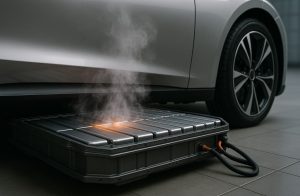Are electric cars truly more prone to fires than traditional vehicles? This question often arises whenever an electric vehicle (EV) fire makes the headlines in the UK or abroad. Many drivers are curious, and sometimes anxious, about the safety of lithium-ion batteries, which power most modern EVs.
While stories about EVs bursting into flames attract wide attention, the statistics tell a more balanced story: electric cars catch fire less often than petrol or diesel vehicles. However, when they do ignite, these fires behave differently, burning at much higher temperatures, lasting longer, and sometimes reigniting days later.
To answer why electric cars catch fire, it is important to look at the causes, the unique characteristics of these fires, and the safety measures being developed to manage the risks.
What Causes Electric Cars to Catch Fire?

The most significant reason electric cars catch fire is thermal runaway. This phenomenon occurs when a single lithium-ion cell overheats, triggering a chain reaction that spreads to neighbouring cells. Once the process starts, the battery generates more heat than it can release, leading to rapid combustion.
Other causes are closely linked to how the batteries are built and used. Physical damage to the battery pack during a crash, even one that looks minor, can create internal weaknesses or punctures that spark fires later. Manufacturing defects also play a role. If battery cells are poorly constructed or contaminated during production, faults may go unnoticed until they result in dangerous overheating.
Charging practices are another factor. Using uncertified or faulty chargers can cause excessive heat buildup, and while most electric vehicles include battery management systems to prevent this, these systems are not infallible. Finally, internal short circuits, often caused by damage or defects, can bypass the battery’s intended pathways, releasing uncontrolled energy as heat.
How Are EV Fires Different from Petrol Car Fires?
While petrol and diesel cars have been catching fire for decades, EV fires are distinctive in how they behave once they ignite. An EV fire burns much hotter than a petrol fire, often reaching temperatures that make firefighting extremely difficult. In addition, extinguished EVs pose the unusual problem of reignition. Chemical reactions within damaged battery cells can smoulder unnoticed, only to flare up again hours or even days later.
Another difference is the release of toxic gases. A burning lithium-ion battery can emit more than one hundred different chemicals, including hydrogen fluoride and carbon monoxide. These gases pose risks not just to occupants and bystanders but also to firefighters and emergency workers who must use specialist equipment to protect themselves.
The table below highlights the main contrasts between EV fires and petrol car fires:
| Feature | Electric Vehicle Fires | Petrol/Diesel Vehicle Fires |
| Main cause | Thermal runaway, internal faults | Fuel leaks, overheating engines |
| Frequency | Less common | More common |
| Temperature | Extremely high, harder to manage | Lower, easier to manage |
| Reignition risk | High – may reignite days later | Low – rarely reignites |
| Toxic emissions | Over 100 chemicals, including toxic gases | Mainly carbon monoxide and hydrocarbons |
Are Electric Cars More Dangerous After Accidents?

Accidents remain one of the leading triggers for EV fires. Even when an accident looks minor from the outside, the internal battery structure can suffer damage that is not immediately visible. A cracked casing or crushed cell may not cause a fire instantly, but hours later the damaged battery can enter thermal runaway.
In one incident reported in Birmingham, an electric hatchback that had been involved in a small car park collision appeared intact at first. Hours later, it caught fire while stationary, causing significant damage to nearby vehicles. This example shows why experts recommend that EV batteries be inspected after any collision, regardless of severity. The risk lies in the hidden damage that may only become apparent long after the event.
Why Do EV Fires Reignite After Being Extinguished?
Reignition is one of the features that makes EV fires so challenging. Even when fire crews successfully put out the visible flames, the chemical reactions inside the cells may continue. These reactions generate heat and gases that can cause the fire to flare up again. In some cases, reignition has been reported days after the original fire was thought to be extinguished.
To manage this risk, fire brigades in the UK are now using new methods such as immersing damaged vehicles in large containers of water or monitoring them with thermal cameras for extended periods. These practices may seem extreme, but they reflect the reality that extinguishing an EV fire is far more complex than dealing with a petrol car blaze.
Why Do EV Fires Release Toxic Gases?
When an EV battery ignites, the materials that make up its cells break down under intense heat. Lithium, cobalt, and other compounds release dangerous fumes when burned.
Among the most concerning is hydrogen fluoride, a highly corrosive gas that can cause severe respiratory problems. Carbon monoxide is another common by-product, alongside dozens of other chemicals, some of which are carcinogenic.
For first responders, this means approaching an EV fire requires more than water and foam. Specialist breathing equipment and safety training are essential to protect against chemical exposure. This chemical risk is one of the key differences between EV and petrol car fires and one reason why emergency services continue to adapt their strategies for dealing with EV incidents.
What Can Drivers Do to Prevent EV Fires?
Although the risks associated with lithium-ion batteries cannot be eliminated entirely, drivers can significantly reduce the likelihood of a fire through good practices. One of the most important steps is to always use certified charging equipment. Uncertified or incompatible chargers can cause overheating, while certified ones include safeguards to regulate power flow.
Regular inspections are also essential. Even after what seems like a small accident, drivers should have their vehicle’s battery checked by professionals.
Many fires occur not immediately after an incident but hours or days later due to undetected damage. At home, ensuring that the charging system is professionally installed and compliant with UK safety standards is also a crucial step in preventing risks.
Are EV Fires Over-Reported Compared to Petrol Car Fires?

Yes. Petrol and diesel cars remain far more likely to catch fire overall, yet EV fires attract much more attention in the media. The reason is partly novelty: electric cars are still new to many consumers, so incidents involving them tend to generate headlines. The dramatic nature of EV fires, longer burning, harder to control, and more toxic also makes them more newsworthy.
However, statistics from UK government transport reports make clear that petrol vehicles account for the overwhelming majority of fires on the road. This perspective is often overlooked in popular coverage, which can give the misleading impression that EV fires are frequent.
Will Future Electric Cars Be Less Prone to Fires?
The future of EV safety looks promising. Researchers and manufacturers are already addressing the weaknesses of current battery technology.
Solid-state batteries, which replace liquid electrolytes with solid materials, are expected to be much less flammable than today’s lithium-ion batteries. Improved thermal management systems are also being developed to regulate battery temperature more effectively, reducing the chances of overheating.
Governments, including the UK, are also introducing stricter safety standards and testing requirements for EV batteries. As these measures take effect, drivers can expect electric cars to become even safer, making the risks of fire increasingly rare.
Conclusion
The question of why do electric cars catch fire often sparks debate, but the facts are clear. EV fires are rarer than petrol car fires, yet they demand more attention because of how they behave once ignited. Thermal runaway, physical damage, overcharging, and internal faults are the key causes, while the intensity, toxicity, and potential for reignition make them unique.
For UK drivers, the takeaway is that EVs remain safe when used responsibly. Certified charging equipment, regular inspections, and awareness of risks are effective ways to minimise danger.
At the same time, advances in technology and safety standards continue to improve EV reliability. Far from being unsafe, electric cars represent one of the most secure paths toward a sustainable transport future.
FAQs
Are EV fires more common than petrol car fires?
No. Petrol and diesel vehicles account for far more fires in the UK, although EV fires tend to attract more media coverage.
Why is thermal runaway so dangerous?
It creates a chain reaction where one overheating battery cell triggers others, producing extreme heat and flames.
Can a minor accident cause an EV fire later?
Yes. Even small impacts may damage battery cells, and fires sometimes occur hours or days after an accident.
Why do EV fires sometimes reignite?
Residual heat and chemical reactions inside damaged battery cells can trigger reignition long after the fire seems out.
Are the fumes from EV fires more harmful?
Yes. Burning lithium-ion batteries release toxic gases, including hydrogen fluoride and carbon monoxide, which pose risks to health.
What role does the Battery Management System play in safety?
It monitors temperature and charging levels, reducing risks of overheating, though it cannot prevent every fault.
Will new battery technology reduce the risk of EV fires?
Yes. Solid-state batteries and improved thermal systems are expected to make future EVs far less likely to catch fire.






